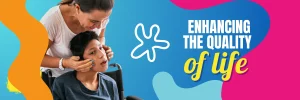Cerebral Palsy (CP) is a complex neurological condition that affects movement and posture, with varying degrees of severity across individuals. To better understand the functional abilities of those with CP, healthcare professionals often use the Gross Motor Function Classification System (GMFCS). This classification system provides a standardised way to assess and describe the motor abilities of individuals with CP, helping guide treatment and interventions.
What is GMFCS?
The Gross Motor Function Classification System (GMFCS) is a tool specifically designed to classify the gross motor function of children and adolescents with cerebral palsy. Developed in the 1980s and refined over the years, the GMFCS helps professionals communicate more effectively about an individual’s capabilities and limitations. It is particularly useful for clinicians, therapists, and families in setting goals for therapy and measuring progress.

The Five Levels of GMFCS
The GMFCS consists of five levels, ranging from Level I (the least involved) to Level V (the most involved). Here is a breakdown of each level:
Level I:
Walks without limitations
- Children can walk independently and participate in various activities without difficulty.
- They may have minor balance issues but can run and jump effectively.
Level II:
Walks with limitations
- Children can walk independently but may have limitations in their ability to run or jump.
- They might require a handrail on stairs or have difficulty walking long distances.
Level III:
Walks using a hand-held mobility device
- Children can walk with assistance, such as a walker or cane.
- They may also use a wheelchair for longer distances but can mobilise independently over shorter distances.
Level IV:
Self-mobility with limitations
- Children may be able to walk for short distances with the use of assistive devices or assistance from others.
- Most often, they use a wheelchair for mobility and may require support in daily activities.
Level V:
Transported in a wheelchair
- Children have significant limitations in their ability to move independently and require a wheelchair for mobility.
- They may have severe impairments in their ability to control their movements and often need assistance with daily activities.

Importance of the GMFCS
The GMFCS classification plays a crucial role in several areas:
- Treatment Planning: By identifying a child’s level of gross motor function, therapists can develop targeted interventions and set realistic goals that are tailored to the individual’s capabilities.
- Communication: The GMFCS provides a common language for healthcare professionals, families, and educators, facilitating discussions about the child’s abilities and needs.
- Research and Outcomes Measurement: The GMFCS is widely used in clinical research to evaluate the effectiveness of treatments and interventions, enabling the comparison of outcomes across studies.
- Long-Term Planning: Understanding a child’s level of gross motor function can help families plan for future needs, including mobility aids, educational support, and other resources.
Limitations of the GMFCS
While the GMFCS is a valuable tool, it is important to recognise its limitations:
- Focus on Gross Motor Function: The GMFCS primarily assesses gross motor abilities, but does not address other aspects of function, such as fine motor skills, cognitive abilities, or communication.
- Age-Dependent: The classification is most applicable to children and may not reflect the abilities of adolescents or adults as they grow and develop.
Conclusion
The GMFCS classification for cerebral palsy is an essential tool that helps families, healthcare providers, and educators understand and communicate about an individual’s gross motor abilities. By providing a clear framework for assessment, the GMFCS supports tailored interventions and long-term planning, ultimately enhancing the quality of life for individuals with CP.
If you have questions about the GMFCS or cerebral palsy, don’t hesitate to reach out to healthcare professionals or support organisations. Understanding the complexities of CP can empower individuals and families to advocate for the best possible care and support.
